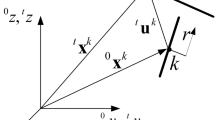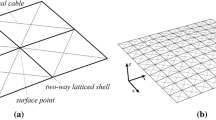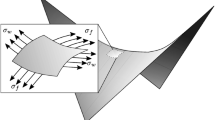Abstract
In order to eliminate stress-related wrinkles in cable-suspended membrane structures and to provide simple and reliable deployment, this study presents a multi-material topology optimization model and an effective solution procedure for generating optimal connected layouts for membranes and cables. On the basis of the principal stress criterion of membrane wrinkling behavior and the density-based interpolation of multi-phase materials, the optimization objective is to maximize the total structural stiffness while satisfying principal stress constraints and specified material volume requirements. By adopting the cosine-type relaxation scheme to avoid the stress singularity phenomenon, the optimization model is successfully solved through a standard gradient-based algorithm. Four-corner tensioned membrane structures with different loading cases were investigated to demonstrate the effectiveness of the proposed method in automatically finding the optimal design composed of curved boundary cables and wrinkle-free membranes.









Similar content being viewed by others
References
Mikulas MM, Adler AL (2003) Rapid structural assessment approach for square solar sails including edge support cords. In: 44th AIAA/ASME/ASCE/AHS structures, structural dynamics, and materials conference, 7–10 April, Norfolk, Virginia
Murphey M, Murphy D, Mikulas M, Adler AL (2002) A method to quantify the trust degradation effects of structural wrinkles in solar sails. In: 43rd AIAA/ASME/ASCE/AHS Structures, structural dynamics, and materials conference, AIAA-2002-1560, Denver, CO
Masahisa F, Osamu K, Seiichiro F (1989) Analysis of fabric tension structures. Comput Struct 32:537–547
Wong YW, Pellegrino A, Park KC (2003) Prediction of wrinkle amplitudes in square solar sails. In: 44th AIAA/ASME/ASCE/AHS structures, structural dynamics, and materials conference, 7–10 April, Norfolk, Virginia
Senda K, Petrovic M, Nakanishi K (2015) Wrinkle generation in shear-enforced rectangular membrane. Acta Astronaut 111:110–135
Brau F, Damman P, Diamant H, Witten TA (2013) Wrinkle to fold transition: influence of the substrate response. Soft Matter 9:8177–8186
Huang Y, Chen H, Wu J, Feng X (2014) Controllable wrinkle configurations by soft micro-patterns to enhance the stretchability of Si ribbons. Soft Matter 10:2559–2566
Huang Q, Hu H, Yu K, Potier-Ferry M, Belouettar S, Damil N (2015) Macroscopic simulation of membrane wrinkling for various loading cases. Int J Solids Struct 64–65:246–258
Xu F, Potier-Ferry M (2016) A multi-scale modeling framework for instabilities of film/substrate systems. J Mech Phys Solids 86:150–172
Kim JY, Lee JB (2002) A new technique for optimum cutting pattern generation of membrane structures. Eng Struct 24:745–756
Punurai W, Tongpool W, Morales JH (2012) Implementation of genetic algorithm for optimum cutting pattern generation of wrinkle free finishing membrane structures. Finite Elem Anal Des 58:84–90
Akita T, Natori MC (2008) Sensitivity analysis method for membrane wrinkling based on the tension-field theory. AIAA J 46(6):1516–1526
Yan D, Zhang K, Peng F, Hu G (2014) Tailoring the wrinkle pattern of a microstructured membrane. Appl Phys Lett 105:071905
Duan B, Gao F, Du J, Zhang S (2015) Optimization and experiment of an electrostatic forming membrane reflector in space. J Mech Sci Technol 29(4):1355–1360
Lim CW, Toropov VV, Ye J (2012) Shape optimization of membrane structures based on finite element simulation. In: Proceedings of the eleventh international conference on computational structures technology, Civil-Comp Press, Stirlingshire
Sakamoto H, Park KC, Miyazaki Y (2005) Dynamic wrinkle reduction strategies for cable-suspended membrane structures. J Spacecr Rockets 42(5):850–858
Sakamoto H, Park KC, Miyazaki Y (2007) Evaluation of membrane structures designs using boundary web cables for uniform tensioning. Acta Astronaut 60:846–857
Dinh TD, Rezaei A, Punurai W, De Laet L, Mollaert M, Van Hemelrijck D, Van Paepegem W (2016) A shape optimization approach to integrated design and nonlinear analysis of tensioned fabric membrane structures with boundary cables. Int J Solids Struct 83:114–125
Sigmund O, Maute K (2013) Topology optimization approaches. Struct Multidiscip Optim 48(6):1031–1055
Deaton JD, Grandhi RV (2014) A survey of structural and multidisciplinary continuum topology optimization: post 2000. Struct Multidiscip Optim 49(1):1–38
Sigmund O, Torquato S (1997) Design of materials with extreme thermal expansion using a three-phase topology optimization method. J Mech Phys Solids 45(6):1037–1067
Yin L, Ananthasuresh GK (2001) Topology optimization of compliant mechanisms with multiple materials using a peak function material interpolation scheme. Struct Multidiscip Optim 23(1):49–62
Zhou S, Wang MY (2007) Multimaterial structural topology optimization with a generalized Cahn–Hilliard model of multiphase transition. Struct Multidiscip Optim 33(2):89–111
Ramani A (2010) A pseudo-sensitivity based discrete-variable approach to structural topology optimization with multiple materials. Struct Multidiscip Optim 41(6):913–934
Cai K, Cao J, Shi J, Liu L, Qin QH (2016) Optimal layout of multiple bi-modulus materials. Struct Multidiscip Optim 53(4):801–811
Shi J, Cao J, Cai K, Wang Z, Qin QH (2016) Layout optimization for multi-bi-modulus materials system under multiple load cases. Eng Comput. doi:10.1007/s00366-016-0450-5
Tavakoli R (2016) Optimal design of multiphase composites under elastodynamic loading. Comput Methods Appl Mech Eng 300:265–293
Wang MY, Wang X (2004) “Color” level sets: a multi-phase method for structural topology optimization with multiple materials. Comput Methods Appl Mech Eng 193(6–8):469–496
Guo X, Zhang W, Zhong W (2014) Stress-related topology optimization of continuum structures involving multi-phase materials. Comput Methods Appl Mech Eng 268(1):632–655
Wang Y, Luo Z, Kang Z, Zhang N (2015) A multi-material level set-based topology and shape optimization method. Comput Methods Appl Mech Eng 283(1):1570–1586
Ding H, Yang B (2003) The modeling and numerical analysis of wrinkled membranes. Int J Numer Methods Eng 58(12):1785–1801
Miyazaki Y (2006) Wrinkle/slack model and finite element dynamics of membrane. Int J Numer Methods Eng 66:1179–1209
Kang S, Im S (1997) Finite element analysis of wrinkling membranes. J Appl Mech 64:263–269
Duysinx P, Bendsøe MP (1998) Topology optimization of continuum structures with local stress constraints. Int J Numer Methods Eng 43:1453–1478
Kirsch U (1990) On singular topologies in optimum structural design. Struct Multidiscip Optim 2:133–142
Cheng G, Jiang Z (1992) Study on topology optimization with stress constraints. Eng Optim 20:129–148
Cheng G, Guo X (1997) \(\upvarepsilon \)-relaxed approach in structural topology optimization. Struct Multidiscip Optim 13:258–266
Bruggi M (2008) On an alternative approach to stress constraints relaxation in topology optimization. Struct Multidiscipl Optim 36:125–141
Luo Y, Wang MY, Zhou M, Deng Z (2012) Optimal topology design of steel-concrete composite structures under stiffness and strength constraints. Comput Struct 112–113:433–444
Sigmund O (2001) A 99 line topology optimization code written in Matlab. Struct Multidiscip Optim 21(2):120–127
Svanberg K (1987) The method of moving asymptotes—a new method for structural optimization. Int J Numer Methods Eng 24(2):359–373
Tessler A, Sleight DW, Wang JT (2005) Effective modeling and nonlinear shell analysis of thin membranes exhibiting structural wrinkling. J Spacecr Rockets 42(2):287–298
Acknowledgements
This work is supported by the National Natural Science Foundation of China (11472215, U1508209, 11425207, 11672056) and the Fundamental Research Funds for the Central Universities (DUT15RC(3)026)
Author information
Authors and Affiliations
Corresponding authors
Rights and permissions
About this article
Cite this article
Luo, Y., Niu, Y., Li, M. et al. A multi-material topology optimization approach for wrinkle-free design of cable-suspended membrane structures. Comput Mech 59, 967–980 (2017). https://doi.org/10.1007/s00466-017-1387-2
Received:
Accepted:
Published:
Issue Date:
DOI: https://doi.org/10.1007/s00466-017-1387-2




